Everyday Art & Music
Art, especially in everyday items, and music were present on the frontier in Tennessee. Although their lives might be sparse and hard, early pioneers enjoyed attractive items. Music was also an entertainment in an age that didn’t have television or radios.
Wealthy individuals often commissioned painters to paint portraits of themselves and their family members. The first professional artist to work in Tennessee was probably Ralph E. W. Earl, who became known for his portraits of Andrew Jackson. Earl opened the first museum in Nashville in 1818 to display his paintings, one of which can still be seen today at the Tennessee State Museum.
The earliest known painting in Tennessee is probably Deaderick’s Hill by Rebecca Chester, a painting of her family’s home, the Chester Inn, in Jonesborough. Other early art works include board paintings at the Carter House, also in Jonesborough, which were painted around the 1780s.
Furniture makers made decorative pieces, many of which were purchased by notable Tennessee families. John Rose, James B. Houston, and William Winchester, Jr., produced exquisite desks, dressers, sugar chests and sideboards. Even so, simpler furniture styles made out of necessity by locals were common on the frontier, especially in the earliest times.
Many everyday items, including samplers, quilts, saddles, and even weapons, were personalized, using an artful eye. Women sewed quilts and pillow cases for bedding, but also would make them attractive—depending on their artistic abilities.
Girls made embroidered samplers for display on the walls of the house. Many included Biblical quotes along with letters of the alphabet and numbers to help girls practice sewing skills while they learned.
Pottery was made in Tennessee by Indians for thousands of years. By frontier times, European and African influence changed the way Native Americans made pottery. A style often called Colono-ware by archeologists today was made or used at many historic Indian sites throughout the state.
In addition, family-based operations making glazed pottery were set up in East Tennessee. By the 1820s, family kilns were making a durable type called stoneware. The pottery designs of the frontier days were rather plain; however, the salt-glaze gave them an artistic sheen.
One might not think of weapon-making as an art, but Tennesseans certainly excelled in it. For example, William Bean, who settled in East Tennessee in 1769, and his grandson Baxter made decorative weapons, using wood from local trees and imported metal parts.
Often, powder horns for holding black powder were personalized in artistic ways. One had decorative inscriptions, “Don’t Tread on Me” and “Love Liberty,” showing the owner’s reverence for the American Revolution.
Music
Despite the dangers on the frontier, settlers of all backgrounds found time for music. It was a primary form of entertainment. This music was performed either by singing or playing an instrument.
Many cultures contributed to musical development in Tennessee, but during the frontier period, most music which settlers enjoyed came from English or Scottish traditions. At the same time, slaves and Indians had musical styles based on their own traditions. Eventually there was a blending of styles.
Songbooks and sheet music were brought over the mountains either by the settlers themselves or by traders who sold them to the locals. Blacks used African styles taught to them by their parents.
Instrumental dance tunes, like Turkey in the Straw, were often performed by fiddle players. Fiddlers and players of other instruments, like harps and harmonicas, were often called upon to perform at barn dances and other social functions.
Slaves brought a tradition of group singing, usually led by one person with a call-and-response action (often called
field hollers). They would often sing while they were working, using African rhythms. The songs helped the time to pass and was a way to entertain themselves. To listen to a modern version of a slave song,
click here.
Religious ballads, hymns, and revival songs were common. The simplicity of religious songs and the use of shape-note songbooks allowed people who could not read musical notes to sing.
http://tn4me.org/audio/ComeThyFount.mp3
Listen to a religious song popular on the frontier. The music you are hearing was produced by noted musician David Schnaufer in 2001 using a dulcimer made in 1830 in Sneedville, Tennessee. The song is “Come Thou Fount of Every Blessing,” written by Robert Robinson in 1758, although the melody was written later. Songs were often set to different tunes.
Picture Credits:
- A painting inscribed at the bottom as "A Full View of Deadrick's Hill." This is the earliest known painting done in Tennessee, completed in 1811. It was painted by Rebecca Chester of the scene in Jonesborough. The large house is Poplar Hill, built by David Deadrick who came to Tennessee in 1783. The hill is named for him. Tennessee State Museum Collection, 82.146
- A portrait of Dr. James Priestly, by Ralph E.W. Earl. Priestley was the first president of Cumberland College (later the University of Nashville). This portrait was done about 1815. Earl is best known for his paintings of Andrew Jackson and his family. Tennessee State Museum Collection, 1.831
- Painting of Elizabeth Banks Boyer of Gallatin in her wedding dress, shortly after her marriage to Robert Boyers in 1817. Although she looks younger, records indicate she was probably 20 years old at the time of her marriage. Tennessee State Museum Collection, 83.30
-
A painting inscribed at the bottom as "A Full View of Deadrick's Hill." This is the earliest known painting done in Tennessee, completed in 1811. It was painted by Rebecca Chester of the scene in Jonesborough. The large house is Poplar Hill, built by David Deadrick who came to Tennessee in 1783. The hill is named for him. Tennessee State Museum Collection, 82.146
-
A portrait of Dr. James Priestly, by Ralph E.W. Earl. Priestley was the first president of Cumberland College (later the University of Nashville). This portrait was done about 1815. Earl is best known for his paintings of Andrew Jackson and his family. Tennessee State Museum Collection, 1.831
-
Painting of Elizabeth Banks Boyer of Gallatin in her wedding dress, shortly after her marriage to Robert Boyers in 1817. Although she looks younger, records indicate she was probably 20 years old at the time of her marriage. Tennessee State Museum Collection, 83.30
-
Drawing entitled, “Chilion playing.” It shows a man playing the fiddle and a group of people listening to the music. It was made by Felix O. C. Darley sometime between 1875 and 1889. New York Public Library
-
Drawing entitled, “Old Shine; The Paganini of New Kent, Virginia.” This drawing depicts an African American fiddler in 1803. New York Public Library
-
Photograph showing a frontier re-enactor inkle weaving. It shows a girl weaving a sash. This photo was taken in 2007 at the Sycamore Shoals State Park in Elizabethton, Tennessee. Friends of Sycamore Shoals State Historic Area
-
Photograph showing a group of frontier re-enactors participating in the broom dance. This photo was taken in 2006 at Historic Mansker’s Station in Goodlettsville, Tennessee. Andrew Ward, Republican Plumbing
- Photograph of the Overmountain Singers. This photo was taken sometime before 2005 at Sycamore Shoals State Park in Elizabethton, Tennessee. It shows three women musicians each holding a musical instrument including a dulcimer, bodhran drum, and a guitar. A male singer is also shown. The Overmountain Singers

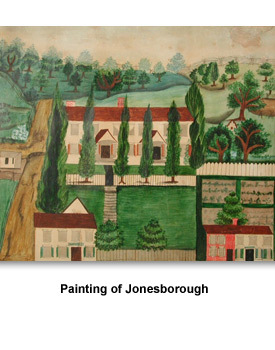
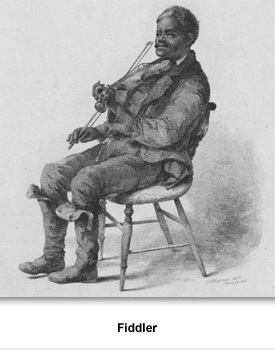
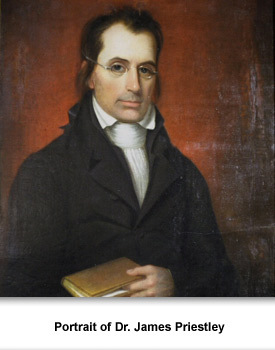
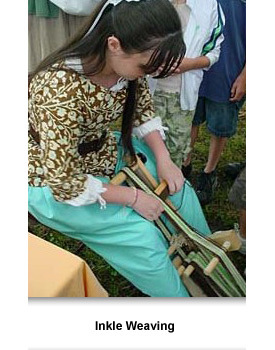
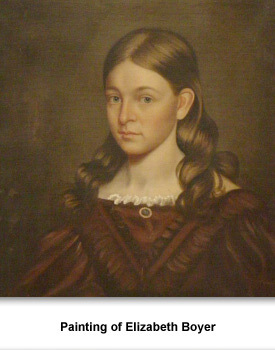
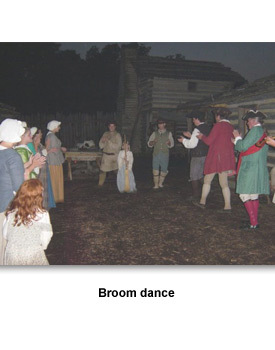
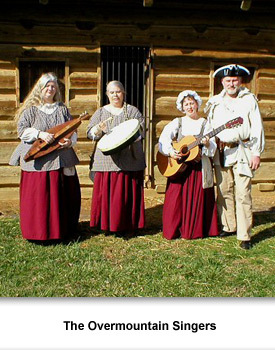
 Sponsored by: National Endowment for the Humanities
Sponsored by: National Endowment for the Humanities